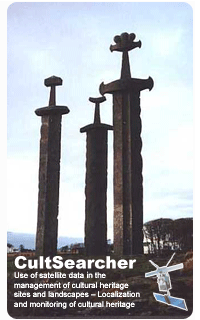Main activities
Main activities
- Detection of hunting systems and iron extraction sites
- Detection of burial mounds in forested land
- Detection of levelled burial mounds in agricultural land
- Web portal for processing new data sets
Detection of hunting systems and iron extraction sites
The project has developed an automatic method for detecting pits in airborne laser scanning data. This method is in use by archaeologists in Oppland County for the mapping of ancient hunting systems and iron production sites.
A hunting system usually consists of a series of pitfall traps. These are visible in the terrain today as u-shaped pits.

A pitfall trap that the automatic pit detection method was able to . Top left: hillshaded relief model of the lidar data, for visual interpretation by humans. Top right: terrain elevation model of the lidar data, suitable for the automatic pit detection method. Bottom: photo from field inspection.
Detection of burial mounds in forested land
The project is currently developing an automatic method for detecting heaps in airborne laser scanning data. This method is now being evaluated by archaeologists in Vestfold County for the mapping of grave mounds in forested areas.


Grave mounds, Larvik municipality. Left: in Bøkeskogen. Right: in Brunlafeltet.

Preliminary detection results. The white polygon denotes the extent of the grave field from a previous survey. The coloured circles are automatic detections, with confidence levels: very high (blue), high (cyan), medium high (green), medium (yellow), low (orange), and very low (red). The red square indicates a grave mound with a very distinct looting pit.
Detection of levelled burial mounds in agricultural land
The project has acquired several very high resolution satellite images of agricultural land, mainly in Vestfold. Archaeologists have identified many circular patterns in the images. These patterns are believed to be the remains of burial mounds. For each of these, the mound itself has been destroyed, but a circular ash-filled ditch often remains under the tilled layer. If the surrounding soil is not too ewt, the ash-filled ditch may create different soil moisture and growing conditions for cereals, resulting in circular soil marks before the growing season starts, and crop marks at the end of the growing season, just before harvesting. The soil marks and crop marks are not guarenteed to manifest themselves every year, and they are visible only for a limited time.

Four circular soil marks clearly visible in a Quickbird image of Lågendalen, Vestfold County, acquired on 27 April 2005.
The automatic detection method consists of the following steps:
- local contrast enhancement;
- template matching;
- feature extraction;
- decision-tree-based classification.
The method is optimized to work on the 0.6 m resolution panchromatic band of Quickbird images.
We also plan to develop a similar method for aerial photography of 0.1-0.5 m resolution.
Web portal for processing new data sets
We are developing a web portal to be used by archaeologists in the county administrations in Norway.
Whenever new lidar data sets are avialiable, they can be uploaded on the portal and the automatic detection methods be applied. The portal emails detections in the form of shape files, with one layer for each of the six confidence levels. The resulting detections will have to be verified by archaeologists, first visually, and if necessary, by field inspection.

